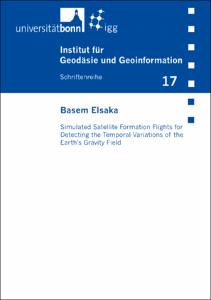Elsaka, Basem: Simulated satellite formation flights for detecting the temporal variations of the Earth's gravity field. - Bonn, 2010. - , . In: Schriftenreihe / Institut für Geodäsie und Geoinformation, 17.
Online-Ausgabe in bonndoc: https://hdl.handle.net/20.500.11811/1400
Online-Ausgabe in bonndoc: https://hdl.handle.net/20.500.11811/1400
@phdthesis{handle:20.500.11811/1400,
author = {{Basem Elsaka}},
title = {Simulated satellite formation flights for detecting the temporal variations of the Earth's gravity field},
school = {},
year = 2010,
series = {Schriftenreihe / Institut für Geodäsie und Geoinformation},
volume = 17,
note = {In this thesis, the concept of satellite formation flight (SFF) is studied by means of simulated satellite observations. With various formation types enabling inter-satellite measurements in various directions (e.g. along-track, cross-track or radial), the principal tasks in global gravity field recovery are tackled: the determination of the static gravity field and the detection of its temporal variations. The investigated formation flight types include GRACE, Pendulum, GRACE-Pendulum, Radial wheel and Inclined wheel configurations. For each formation type, appropriate orbit parameters are determined to receive homogeneous subsatellite track patterns required for a high spatial resolution. In addition, orbit designs are developed which allow an enhancement of the temporal resolution (i.e. sub-month solutions). The investigated formation flight types of this case include GRACE-24days, GRACE-12days, Multi-GRACE ΔM and Multi-GRACE ΔΩ configurations.
In the static gravity field analysis, the test scenarios cover different spectral ranges of the Earth’s gravity field up to the spherical harmonics degree 180. The detection of the temporal variations is performed using physical models from ocean tides, atmosphere, ocean and continental hydrology. The numerical computations show that significant improvements are achieved from the formation flights for the recovery of the global static gravity field and the detection of its temporal variations. Thus, the study provides an outlook on the progress in the gravity field modeling that is achievable by future satellite missions.},
url = {https://hdl.handle.net/20.500.11811/1400}
}
author = {{Basem Elsaka}},
title = {Simulated satellite formation flights for detecting the temporal variations of the Earth's gravity field},
school = {},
year = 2010,
series = {Schriftenreihe / Institut für Geodäsie und Geoinformation},
volume = 17,
note = {In this thesis, the concept of satellite formation flight (SFF) is studied by means of simulated satellite observations. With various formation types enabling inter-satellite measurements in various directions (e.g. along-track, cross-track or radial), the principal tasks in global gravity field recovery are tackled: the determination of the static gravity field and the detection of its temporal variations. The investigated formation flight types include GRACE, Pendulum, GRACE-Pendulum, Radial wheel and Inclined wheel configurations. For each formation type, appropriate orbit parameters are determined to receive homogeneous subsatellite track patterns required for a high spatial resolution. In addition, orbit designs are developed which allow an enhancement of the temporal resolution (i.e. sub-month solutions). The investigated formation flight types of this case include GRACE-24days, GRACE-12days, Multi-GRACE ΔM and Multi-GRACE ΔΩ configurations.
In the static gravity field analysis, the test scenarios cover different spectral ranges of the Earth’s gravity field up to the spherical harmonics degree 180. The detection of the temporal variations is performed using physical models from ocean tides, atmosphere, ocean and continental hydrology. The numerical computations show that significant improvements are achieved from the formation flights for the recovery of the global static gravity field and the detection of its temporal variations. Thus, the study provides an outlook on the progress in the gravity field modeling that is achievable by future satellite missions.},
url = {https://hdl.handle.net/20.500.11811/1400}
}






